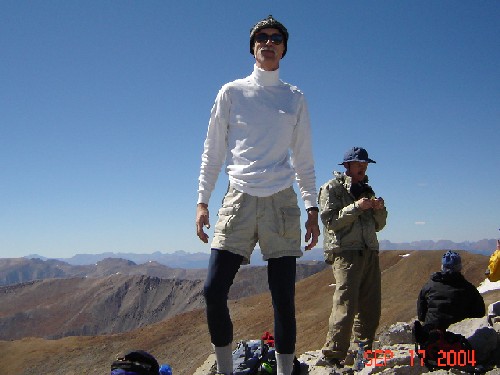It didn’t seem reasonable to trust that my ankle, which I strained just three weeks ago (see Stove Mountain), was really up for the whole 22-mile round trip from the house, but I figured it could stand up to the 13-mile round trip and 4,000 foot elevation gain from the Gold Camp Road parking lot in North Cheyenne Cañon. So I put on several layers on my torso, long running pants, and heavy mittens and a hat, and headed up to the parking lot just after sunrise (which nowadays is shortly after
Only a tiny amount of ice and packed snow remained on the shady section of the trail in Buffalo Cañon. After that, the trail was deliciously bare all the way to St. Mary’s Falls and through the switchbacks beside it, including the steep, loose section where I had slipped back in October. Near here, I overtook a group of five hikers, who turned out to be the only people I saw on the entire ascent. As I tooled on up by the falls, I knew I wasn’t setting any speed records, but I wasn’t really doing too badly on time: Everything felt OK, and I felt no need to stop and rest.
At the usual place, where the trail plunges back into denser trees at around 9,400 ft., I started to see patches of shallow snow. They were mostly nicely crusted over, however, and those which couldn’t be bypassed could mostly be walked over. I decided that I could wait until I got higher to decide whether or not to don the gaiters I had brought.
As I worked my way up the east-facing slopes toward the north ridge of Rosa, the wind, basically out of the south, began to pick up. I was still mostly sheltered from it by the trees, but it certainly made plenty of noise in those trees. It squelched any thought of shedding any layers any time soon, and made me glad that I had worn heavy wool mittens with shells, in addition to packing lighter mittens in my back.
Sure enough, topping out on the ridge immediately exposed me to strong and gusty winds, foretelling a chilly slog to the summit. The ridge was mostly blown bare of snow, but, upon arriving at the base of the north-facing summit slope, where the trail again heads into fairly dense timber, I finally encountered widespread snow cover, varying from six to twelve inches deep. In the shade of the trees, it was possible to sink into it, so I took the first reasonable opportunity to stop and put on my gaiters.
The brief rest—actually the first I had taken—put new spring in my steps. Even better, I found that the tracks of two or three parties who had come up this way since last snow were well packed on the bottom, so stepping directly in their modest postholes obviated the need for me to make any of my own.
I was able to follow tracks all the way to the top, except for the exposed sections where the wind had scoured the snow. There, ample areas of the trail were actually bare, and the remaining snow was very windpacked, and easy to walk over.
At
I was pleased to find that the previous, badly beaten-up, register, had been replaced earlier this year. I was only slightly surprised to see nearly ten pages of entries since then. I had brought a blank register with me, but happily didn’t need to fish it out of my pack and fill it out. I say happily because the wind made just getting the existing register out of the canister, handling it, and adding my own entry a real ordeal. I spent just five minutes on the summit before heading down.
I was also pleased to note that my ankle was still holding up, even downhill through the mix of postholes and bare rocks. I did have to moderate my speed a bit on the descent, but still experienced no real joint problems on the return trip. I didn’t set any speed records, but a lot of my time can be chalked up to that 500 vertical feet of snow at the top. It would have been slow, both ways, in any case.
I also decided to do something I’ve thought about numerous times before: veer off the trail at the saddle, and visit the minor summit to
My descent time was
Long life and many peaks.

